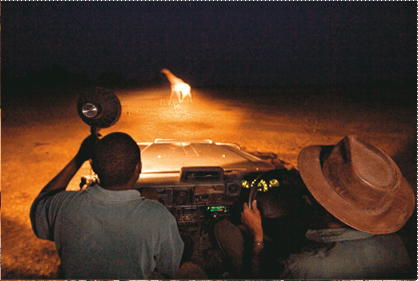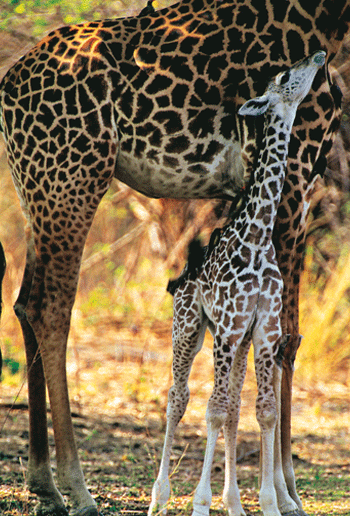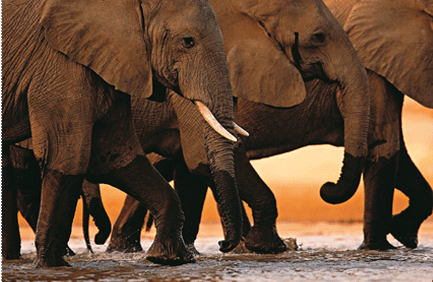
 ZAMBIA
ZAMBIA
The Last Real
Intimate encounters with animals on their own terms are among the hallmarks – and thrills – of a walking safari.
Photos: Frans Lanting*
By: Christine k. Eckstrom*
“If the lions come bounding toward us, don’t move,” Robin Pope whispered to me. “Just wait for my instructions.”
He turned to the lions, three females and six cubs, about 20 yards in front of us. We were on foot, far from any climbable tree. The lions rarely took their eyes off us, ears perked, tail tips twitching. One frisky older cub took a few steps our way; his mother rose up. I mentally counted the bounds.
Getting close to lions on foot may seem counterintuitive, but in
With three companions, I joined him for a three-day walking safari along the Luangwa, a 500-mile-long river that loops through a remote wilderness valley that stretches across some 20,000 square miles in the heart of south-central
That is changing rapidly, and I came here to explore what sets
Nearly three decades ago, Robin Pope, born in South Africa and raised in the Zambian bush, was hired as a walking safari guide in Zambia by Norman Carr, the game ranger turned conservationist and ecotourism pioneer whose influence is still reflected in every lodge and camp in Luangwa Valley. Carr invented the idea of walking safaris, and its code of ethics, and then trained a generation of guides who carry on the tradition.
Intimate encounters with animals on their own terms are among the hallmarks – and thrills – of a walking safari, and Robin likes to get close, but he doesn’t take foolish risks.
“You must walk in constant anticipation, with every sense cocked for the unexpected,” he says as we set out one morning at dawn, “and always listen to your sixth sense.”
Walking on foot in the African bush sets every sense on high alert. Sounds and scents amplify – the too-loud crunch of footsteps through dry sausage tree leaves, the overpowering gardenia-scent of holarrhena blossoms. Everything seems important – a cracking branch, an impala’s alarm bark, the faint smell of death, somewhere, blowing in on a soft wind – what does it mean? Are the lions near?
 Robin moves at a steady pace as we wind through groves of leadwood and mahogany trees, through rattle-dry mopani woodlands and tangled thickets of capparis bush, stopping for anything interesting: a pile of polka-dot guinea fowl feathers (all that’s left), a few porcupine quills (looks like he got away), hyena scat (white as the bones they eat), lion spoor (fresh).
Robin moves at a steady pace as we wind through groves of leadwood and mahogany trees, through rattle-dry mopani woodlands and tangled thickets of capparis bush, stopping for anything interesting: a pile of polka-dot guinea fowl feathers (all that’s left), a few porcupine quills (looks like he got away), hyena scat (white as the bones they eat), lion spoor (fresh).
Walking with Robin is so absorbing that I sometimes forget about danger. But there is a fifth person with us, without whom no walking safari would be possible (and without whom we would never have approached the lions), and that is an armed scout from the Zambian Wildlife Authority. On every walking safari a scout joins the guide to lead the party, carrying a rifle with firepower enough to stop an elephant, if he must.
Before returning to camp for a midday break, Robin leads us down a steep gully to the river, where dozens of hippos loll in a pool near shore, up to their eyes. We creep low in a line to approach them, and then Robin and Ison Simwanza, our scout, quickly turn and nod to a billowing cloud of dust on the opposite bank, as a big herd of Cape buffalo spreads across the sandy flats in an ever widening brown wall, heading down to the river to drink.
I crouch in the center and all together we move as a unit, shuffling along the edge of the river, showing a profile, we hope, like that of a single buffalo. The herd doesn’t notice. We reach a point directly opposite them, 20 to 30 yards away, and we all lower down to our bellies and watch them drink, huffing and sloshing at the water’s edge – so close we can smell their musky bovine scent and see the raw muscular power under their skin.
 Tea with Giraffes
Tea with Giraffes
“May I pour your tea?” asks Babette Alfieri, holding a steaming thermos. Over her shoulder some 15 yards away, a group of nine giraffes stares languidly at our group of six, seated on a picnic cloth beneath an old sausage tree, having tea in the company of the animals we’ve been following on foot all morning.
Our guide Phil Berry knows more about the natural history of
Our walk has been delightfully giraffe-paced, with long, smooth strolls through dry grass at an oblique angle to the giraffes followed by contemplative pauses a polite distance away as we watch them browse. We’re walking through a storybook African landscape of tall grasses and majestic sausage trees with broad leafy boughs and dangling baguette-shaped fruits, which the giraffes like to nibble when the fruits are small.
Phil and his partner, Babette, set a tone of mellow pleasure as we meander with the giraffes, accompanied by a tea bearer, Moses Zulu, a porter, Joseph Changa-changa, and a scout, Isiaih Nyirenda, whose eyes never stop scanning.
Now beneath the tree Phil relaxes with tea and cake, eyeing female #F20, who is peering at us through the leaves of an adjacent sausage tree.
“I first saw her five years ago,” says Phil. “She was not part of my original study, but I’m still making notes on her and a number of other females.” Phil is interested in females because of their interactions with offspring over time.
“I’ve recorded how offspring and their mothers come together again in the wild. In some cases I’ve seen as many as five offspring and one mother meet up, weeks after separating, and they travel together, wander off, and join up again,” he continues. “We used to think that we were the only ones with emotions, but we know very well now that this isn’t so – primates and elephants are prime examples. I’m sure that giraffes and lions and leopards all recognize each other long after they’ve been apart.”
Flying the Landscape of Life
“Ready?” asks John Coppinger, and a few seconds after my “Yes” he revs the engine and we race down a dirt runway in his microlight and lift up into the cool dawn air. We spiral up in big circles like a stork riding a thermal and then trace a route along the looping
I hang on, seated motorcycle-passenger style behind him as we fly above Tafika, the bush camp perched along a bend of the
Born and raised in
Now, as we lift higher, we fly over a line of people walking a trail, single file, heading to Tafika from Mkasanga, a nearby village of perhaps 1,500 people – 100 of whom work at Tafika, the main source of local employment. Mkasanga is the village that powers the camp, and it has a special place in exploration history, as the spot where Dr. David Livingstone crossed the
We angle away from the village and head north along a meandering section of the
 “There’s so much variety in habitat – and because the valley floor is so flat, the river changes course easily,” John says. “When it floods, it can cover this whole area with water, like a lake – and all the nutrients are distributed across these plains.”
“There’s so much variety in habitat – and because the valley floor is so flat, the river changes course easily,” John says. “When it floods, it can cover this whole area with water, like a lake – and all the nutrients are distributed across these plains.”
The
ttled. Ruled by extreme seasonal swings, the valley is virtually impassible by vehicle for half the year, when annual rains turn local “black cotton soils” to a gluey mud that swallows tires, and the river swells from a trickle to a torrent and spills over surrounding lands.
We continue north to reach a remote channel of the river, where we circle above one of the valley’s most spectacular concentrations of hippos – hundreds upon hundreds, packed together like gigantic cobblestones in a long pool along a bend in the river. It’s a classic scene of the late dry season here, when the river dries out and hippos are forced into the last waters deep enough to keep them cool.
Night Stalking
In the moonless blackness, all lights off, we hold still and listen. I hear only the blood beat in my ears, but Derek Shenton hears the leopard. He points a finger, head cocked, and from that direction, an impala barks. Alarm call: The leopard is near.
“Cats tend to stay on a straight-line course once they’ve started,” Derek explains, maneuvering his vehicle through the bush to a place where we might intersect the leopard’s path.
“She wants to hunt,” says Derek, “and there’s no moon – that’s ideal for leopards.” The cat’s movements are marked with more alarm calls that point to her like compass arrows: Pukus whistle, a hollow reedy sound, and farther off, a baboon makes a deep shout-bark, like a dog. The leopard is moving fast.
We go forward again, headlights bobbing on tree trunks and brush as we move in a big arc toward the calls. Suddenly Derek stops and flicks on his spotlight, its beam illuminating a cone-shaped tunnel of dust. He pans and picks up the leopard’s long tail as she disappears into a dark wall of thick bush. “I’m afraid we’ve lost her here,” he says. “She’s gone where we can’t go.”
We circle around a long swath of dense bush to an open grove of trees, where we discover what happened in a blink in the dark: High up in a sausage tree, we spot an impala, freshly killed and dragged up to a big bough, partly obscured by leaves. As I stare through binoculars, in awe of the cat’s chilling power, a big spotted paw reaches over the impala and grips, as if to say “Mine.”
Derek Shenton is uniquely qualified to guide me through the
A night wind is tossing the trees, blowing gusts of dust, as I ride with Derek and Jules in an open vehicle. As Derek drives, he spots animals with discreet bursts of light – long enough to have a good look, but short enough so that they are not overly disturbed. Derek uses red gels on his light if an animal is hunting; red light doesn’t blind them, or dazzle their prey.
While searching for the leopard we spot animals we’d never see in the day – two porcupines scuffling through leaf litter, looking like giant sea urchins; a civet, rushing into the brush, hunched like a raccoon; a Pel’s fishing owl, eyes electric with intensity, high in a tree by the river. We pass a cluster of hippos on land, gathered beneath a sausage tree looking for fruits, then round a bend and encounter seven giraffes, seated on the ground, grouped like ladies at a tea party – secret scenes, never imagined, hidden inside the African night.
Derek likes to find ways to enter the animals’ worlds unseen. At the beginning of each season, he builds a network of hides that makes it easy to get close: a floating canvas blind in the Luangwa, just across from a riverbank colony of carmine bee-eaters; a tree platform in the ebony forest, where elephants pass below; a hippo hide set low in the riverbank, where I sit after dark – with only a thin wall of reeds separating me from 200 hippos – and watch them emerge from the water to feed onshore, glistening wet, carrying the moon on their backs. Sitting in Derek’s newest blind, above a muddy pool along a tributary of the
The elephants fling big sloppy trunkfuls of mud over their backs; the young ones roll in it, and the tiniest baby almost can’t stand up he’s so slick with mud. Derek talks about the poaching of elephants. In the 1970s and ’80s,
Protection, enforcement, and changes in attitude brought an end to that era, although some poaching will always occur, often in the wet season, when most safari camps are closed.
That night I awaken to a rumble. I listen. Twigs snap right outside the window, and I ease over and peer out to see a wall of gray, as a female elephant munches on the tree shading the hut. In the moonlight I can see her tiny calf under her legs, who is still experimenting with how to use its trunk. She moves closer, bumping the hut, feeding on leaves. I hear her chew, hear her stomach groan, hear her breathe. Minutes later, they pad off on the sandy soil, silent.
Writer Christine Eckstrom and photographer Frans Lanting are based in
“We used to think that we were the only ones with emotions, but we know very well now that this isn’t so – primates and elephants are prime examples. I’m sure that giraffes and lions and leopards all recognize each other long after they’ve been apart.”